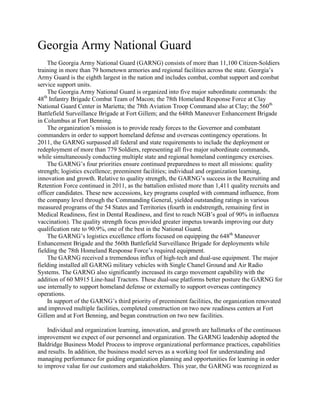Georgia army national guard
- 1. Georgia Army National Guard The Georgia Army National Guard (GARNG) consists of more than 11,100 Citizen-Soldiers training in more than 79 hometown armories and regional facilities across the state. Georgia’s Army Guard is the eighth largest in the nation and includes combat, combat support and combat service support units. The Georgia Army National Guard is organized into five major subordinate commands: the th 48 Infantry Brigade Combat Team of Macon; the 78th Homeland Response Force at Clay National Guard Center in Marietta; the 78th Aviation Troop Command also at Clay; the 560th Battlefield Surveillance Brigade at Fort Gillem; and the 648th Maneuver Enhancement Brigade in Columbus at Fort Benning. The organization’s mission is to provide ready forces to the Governor and combatant commanders in order to support homeland defense and overseas contingency operations. In 2011, the GARNG surpassed all federal and state requirements to include the deployment or redeployment of more than 779 Soldiers, representing all five major subordinate commands, while simultaneously conducting multiple state and regional homeland contingency exercises. The GARNG’s four priorities ensure continued preparedness to meet all missions: quality strength; logistics excellence; preeminent facilities; individual and organization learning, innovation and growth. Relative to quality strength, the GARNG’s success in the Recruiting and Retention Force continued in 2011, as the battalion enlisted more than 1,411 quality recruits and officer candidates. These new accessions, key programs coupled with command influence, from the company level through the Commanding General, yielded outstanding ratings in various measured programs of the 54 States and Territories (fourth in endstrength, remaining first in Medical Readiness, first in Dental Readiness, and first to reach NGB’s goal of 90% in influenza vaccination). The quality strength focus provided greater impetus towards improving our duty qualification rate to 90.9%, one of the best in the National Guard. The GARNG’s logistics excellence efforts focused on equipping the 648th Maneuver Enhancement Brigade and the 560th Battlefield Surveillance Brigade for deployments while fielding the 78th Homeland Response Force’s required equipment. The GARNG received a tremendous influx of high-tech and dual-use equipment. The major fielding installed all GARNG military vehicles with Single Chanel Ground and Air Radio Systems. The GARNG also significantly increased its cargo movement capability with the addition of 60 M915 Line-haul Tractors. These dual-use platforms better posture the GARNG for use internally to support homeland defense or externally to support overseas contingency operations. In support of the GARNG’s third priority of preeminent facilities, the organization renovated and improved multiple facilities, completed construction on two new readiness centers at Fort Gillem and at Fort Benning, and began construction on two new facilities. Individual and organization learning, innovation, and growth are hallmarks of the continuous improvement we expect of our personnel and organization. The GARNG leadership adopted the Baldridge Business Model Process to improve organizational performance practices, capabilities and results. In addition, the business model serves as a working tool for understanding and managing performance for guiding organization planning and opportunities for learning in order to improve value for our customers and stakeholders. This year, the GARNG was recognized as
- 2. a Gold Winner in the Army Community of Excellence program for our business practices. These processes help the leadership establish priorities, focus the organization around them, and unify effort towards accomplishing them. Ultimately, our business models give our seasoned leaders a model to repeat success year after year on a strategic level, thereby giving flexibility to our frontline leaders. These accomplishments continue to set the conditions for the GARNG to be in a position of strength for increased federal funding, future force structure, and full-time manning. (Word Count 589)


